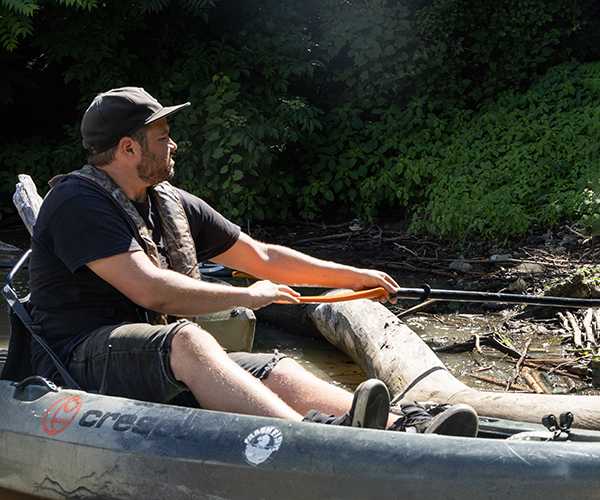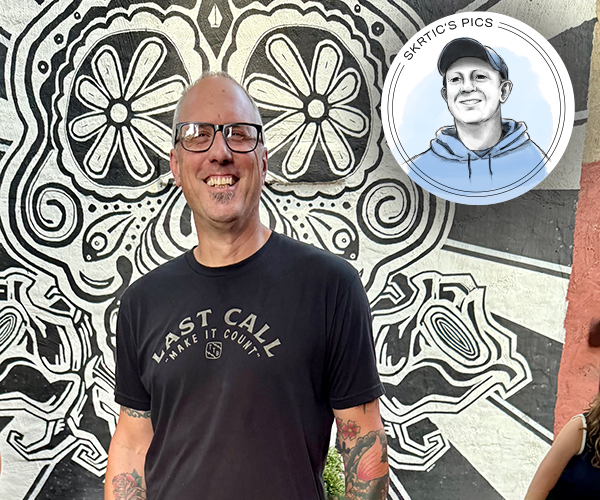Terry Schwarz wants to surprise you.
She helped create the holiday craft sale that popped up in a vacant East Fourth Street storefront in December 2007. The Bazaar Bizarre attracted 600 shoppers during its one-day run and introduced us all to a new way to make use of vacant urban spaces.
Schwarz, a senior planner at the Cleveland Urban Design Center, did not invent the concept, but she’s the one championing it locally under the name Pop Up City. As she modestly puts it, “We just brought it here and gave it a logo.”
Popularized in Germany, the concept aims to help cities that have more space than is needed for their current populations. Cleveland, which has lost nearly 10 percent of its residents since 2000 alone, easily fits the bill.
Schwarz was first exposed to the idea when the Shrinking Cities exposition made a stop here in 2007. The touring expo illustrated how unusual, unexpected happenings can generate energy and excitement. Schwarz was convinced the concept could work after watching acrobatic jump ropers during the expo’s weekend visit here.
“People started spilling out of their houses [to watch],” she recalls. “It was a beautiful moment. ... I thought, This is a useful thing we can use to renew the vitality of the city.”
Schwarz sees Pop Up City as a tool for showcasing sites that are prime spots for redevelopment or reuse. “Like the [Bazaar Bizarre] pop-up shop on East Fourth,” she says. “That space is crying out to be retailed.”
That inaugural Pop Up City affair prompted Schwarz to apply for a $30,000 grant from the Civic Innovation Lab, which financed yet more events: a one-day dog park in the Flats; the transformation of a West 11th Street pedestrian bridge into a one-night outdoor party; and Leap Night in the Flats, which turned the East Bank into a winter wonderland, complete with snowboarding, an ice rink and food vendors.
This month, Schwarz is teaming with the Ingenuity Festival for the Bridge Project, a two-day event Sept. 25 and 26 that will pack the unused trolley level of the Detroit-Superior Bridge with artists and musicians (read our preview of the event on page 71). The Ohio Arts Council is also helping fund the event, providing money to pay for important details such as insurance, security and clean up.
As Schwarz’s Pop Up City concept enters a new phase, she’s looking for partnerships with other organizations, many of which have sought her expertise in return. At press time, Schwarz was working with the Cleveland Executive Fellows, a yearlong training program for future civic leaders, on an Electric Roller Discotech — a mix of roller disco, outdoor bike polo, movies and music — set for Aug. 28 in the former Leff Electric building on East 40th Street.
Schwarz is also putting a twist on the original Pop Up City concept to help reinvent an unsightly piece of property that was once the site of a Glenville/Famicos neighborhood gas station. “It’s frustrating for people who are investing and committing to this neighborhood to have to live with this eyesore,” Schwarz says.
She wants to create a more permanent space where neighborhood residents can stage their own pop-up events. It’s a concept that she’d like to try in other locations throughout the city, too.
“It might encourage artistic entertainment. It might encourage entrepreneurship,” Schwarz says. “If Pop Up City takes hold and becomes an ongoing part of our culture, it might make people stay here.”
She helped create the holiday craft sale that popped up in a vacant East Fourth Street storefront in December 2007. The Bazaar Bizarre attracted 600 shoppers during its one-day run and introduced us all to a new way to make use of vacant urban spaces.
Schwarz, a senior planner at the Cleveland Urban Design Center, did not invent the concept, but she’s the one championing it locally under the name Pop Up City. As she modestly puts it, “We just brought it here and gave it a logo.”
Popularized in Germany, the concept aims to help cities that have more space than is needed for their current populations. Cleveland, which has lost nearly 10 percent of its residents since 2000 alone, easily fits the bill.
Schwarz was first exposed to the idea when the Shrinking Cities exposition made a stop here in 2007. The touring expo illustrated how unusual, unexpected happenings can generate energy and excitement. Schwarz was convinced the concept could work after watching acrobatic jump ropers during the expo’s weekend visit here.
“People started spilling out of their houses [to watch],” she recalls. “It was a beautiful moment. ... I thought, This is a useful thing we can use to renew the vitality of the city.”
Schwarz sees Pop Up City as a tool for showcasing sites that are prime spots for redevelopment or reuse. “Like the [Bazaar Bizarre] pop-up shop on East Fourth,” she says. “That space is crying out to be retailed.”
That inaugural Pop Up City affair prompted Schwarz to apply for a $30,000 grant from the Civic Innovation Lab, which financed yet more events: a one-day dog park in the Flats; the transformation of a West 11th Street pedestrian bridge into a one-night outdoor party; and Leap Night in the Flats, which turned the East Bank into a winter wonderland, complete with snowboarding, an ice rink and food vendors.
This month, Schwarz is teaming with the Ingenuity Festival for the Bridge Project, a two-day event Sept. 25 and 26 that will pack the unused trolley level of the Detroit-Superior Bridge with artists and musicians (read our preview of the event on page 71). The Ohio Arts Council is also helping fund the event, providing money to pay for important details such as insurance, security and clean up.
As Schwarz’s Pop Up City concept enters a new phase, she’s looking for partnerships with other organizations, many of which have sought her expertise in return. At press time, Schwarz was working with the Cleveland Executive Fellows, a yearlong training program for future civic leaders, on an Electric Roller Discotech — a mix of roller disco, outdoor bike polo, movies and music — set for Aug. 28 in the former Leff Electric building on East 40th Street.
Schwarz is also putting a twist on the original Pop Up City concept to help reinvent an unsightly piece of property that was once the site of a Glenville/Famicos neighborhood gas station. “It’s frustrating for people who are investing and committing to this neighborhood to have to live with this eyesore,” Schwarz says.
She wants to create a more permanent space where neighborhood residents can stage their own pop-up events. It’s a concept that she’d like to try in other locations throughout the city, too.
“It might encourage artistic entertainment. It might encourage entrepreneurship,” Schwarz says. “If Pop Up City takes hold and becomes an ongoing part of our culture, it might make people stay here.”
For more information about Terry Schwarz’s Pop Up City initiative, visit cudc.kent.edu.



